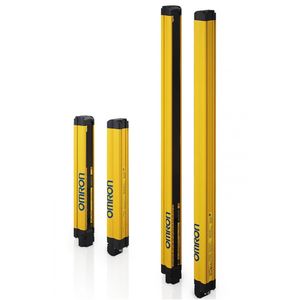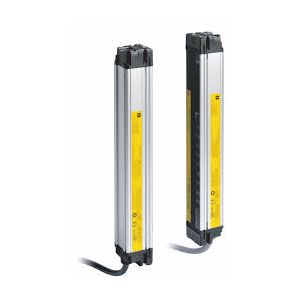Omron Safety Light Curtains
art. F39G0007M
SLCurtain Cable&Connectors
art. F39S0208R
SLCurtain Cable&Connectors
art. F39G0009G
SLCurtain Acces. Opt. & Mech.
art. F39J0155M
SLCurtain Cable&Connectors
art. F39B1002B
SLCurtain Cable&Connectors
art. F39R1005R
SLCurtain Cable&Connectors
art. F39R1013M
SLCurtain Cable&Connectors
art. F39R1006G
SLCurtain Cable&Connectors
art. F39R1007E
SLCurtain Cable&Connectors
art. F39R1003B
SLCurtain Cable&Connectors
art. F39R1010E
SLCurtain Cable&Connectors
art. F39R1011C
SLCurtain Cable&Connectors
art. F39R1004M
SLCurtain Cable&Connectors
art. F39R1012A
SLCurtain Cable&Connectors
art. F39J0002B
SLCurtain Cable&Connectors
art. F39G0003H
SLCurtain Acces. Opt. & Mech.
art. F39G0063A
SLCurtain Acces. Opt. & Mech.
art. F39J0507E
SLCurtain Acces. Opt. & Mech.
art. F39S8201E
SLCurtain Intel features, comm
art. F3SG6001R
SLCurtain Cat4 Finger Protect
art. F3SG6051E
SLCurtain Cat4 Hand Protect
art. F3SG6002G
SLCurtain Cat4 Finger Protect
art. F3SG6052C
SLCurtain Cat4 Hand Protect
art. F3SG6003E
SLCurtain Cat4 Finger Protect
art. F3SG6053A
SLCurtain Cat4 Hand Protect
art. F3SG6004C
SLCurtain Cat4 Finger Protect
art. F3SG6054M
SLCurtain Cat4 Hand Protect
art. F3SG6005A
SLCurtain Cat4 Finger Protect
Omron Safety light curtains are essential safety devices used in industrial automation to protect workers from hazardous areas around machinery. These curtains create an invisible, electronic barrier using a series of infrared light beams emitted by an array of photoelectric sensors. When any object or person interrupts these beams, the light curtain triggers a safety response, typically stopping the machinery to prevent potential injuries.
The primary purpose of safety light curtains is to provide a non-intrusive method of safeguarding dangerous areas. Unlike physical barriers, safety light barrier do not obstruct workflow and allow for easy access to machines while maintaining a high level of curtain safety. This makes them ideal for environments where frequent interaction with machinery is necessary, such as in manufacturing, packaging, and robotic applications.
Key Components of Safety Light Curtains
To understand how safety light curtains work, it's essential to know their key components:
- Emitter: The emitter is responsible for sending out the beams of infrared light. It consists of multiple light-emitting diodes (LEDs) aligned in a vertical or horizontal array, depending on the application. These LEDs emit a continuous stream of light beams across the protected area.
- Receiver: Positioned opposite the emitter, the receiver detects the infrared light beams. It contains a series of photodiodes aligned to correspond with the LEDs in the emitter. When the beams reach the receiver without interruption, the system recognizes that the protected area is clear.
- Control Unit: The control unit processes the signals received from the photodiodes in the receiver. It monitors the status of the light beams and determines if any beams are interrupted. If an interruption is detected, the control unit sends a stop signal to the machinery, ensuring immediate shutdown.
- Mounting Brackets: These are used to securely install the emitter and receiver in the desired location. Proper alignment is crucial for the effective functioning of the light curtain, and mounting brackets provide the necessary stability and adjustability.
- Cabling and Connectors: Cables and connectors are used to link the emitter, receiver, and control unit. They ensure reliable communication between the components and power the system.
- Indicator Lights: Often, curtain safety come with indicator lights on the emitter and receiver units. These lights provide visual confirmation of the system's status, such as alignment, power, and beam interruption.
Types of Omron safety light curtains
Omron offers a wide range of safety light curtains to meet different needs and applications. These lights are used to protect people from dangerous machines and processes, helping to prevent injuries and accidents.
| Type of Curtain | Description | Applications |
| Single-beam curtain | Simplest type, used to protect areas with one access point | - Conveyor lines: protects against hands, clothing or parts being drawn into moving parts of the conveyor. |
| Multi-beam curtain | More complex, protect larger areas | - Robots: protects against access to the robot's workspace while it is moving. |
| Sleeved-beam curtain | Resistant to damage from dirt and dust | - Woodworking machines: protects against the ejection of dust and small wood particles during machine operation. |
| Synchronized curtain | Protect complex hazardous areas | - Multi-arm robots: protects against access to the workspace of the manipulators during their synchronous operation. |
| Safe-zone curtain | Allows access to the hazardous area for a short period of time | - Loading/unloading areas: allows operators to load/unload materials without stopping the machine. |
| Safety category curtain | In accordance with IEC/EN 61496-1/-2 standards | To ensure the safety of workers |
Popular models of Omron safety light curtains
Omron offers a wide range of safety light curtains to suit different needs and applications. Here's an overview of four popular models:
1. Omron F3SG
Description: This model is one of the simplest and most affordable Omron safety light curtains. Its compact design makes it ideal for use in limited space. The F3SG has a single beam and is available in two lengths: 500mm and 1000mm.
Applications: Due to its simplicity and affordability, the F3SG is ideal for protecting single-access hazardous areas such as conveyor lines, workstations and loading/unloading areas.
Examples of use:
- Protection of the operator's hands from being pulled into the conveyor belt.
- Preventing access to the working table of the milling machine during its operation.
- Access control to the loading area of the automatic packaging line.
2. Omron F39
Description: more flexible and powerful light curtain model than F3SG. It can be used with multiple beams, making it ideal for protecting larger areas. The F39 is available in a variety of lengths and heights and can be equipped with additional features such as synchronization and coupled beams.
Applications: F39 is great for protecting complex hazardous areas such as work robots, packaging lines and work cells.
Examples of use:
- Protection of the working space of the manipulator robot during its movement.
- Access control to the loading/unloading area of the robotic packaging line.
- Protection of people from getting into the working cell of the welding robot.
3. Omron F3SJ
Description: Safety light curtain with coupled beams, making it resistant to damage from dirt, dust and other contaminants. It can be used in harsh environments such as woodworking and metalworking machines. The F3SJ is available in different lengths and heights.
Applications: The F3SJ is excellent for protecting hazardous areas in harsh environments where there is a risk of damage from light rays.
Examples of use:
- Protection against the emission of dust and small wood particles during saw operation.
- Preventing sparks and chips from entering the working area of the milling machine.
4. Omron F3W
Description: Safety light curtain with safety category 4 according to IEC/EN 61496-1/-2 standards. This is the highest level of safety available for light curtains. The F3W is perfect for applications where maximum safety is required, such as work robots with hazardous movements or work cells with a high risk of injury.
Fields of application: F3W is used in critical hazardous areas where it is necessary to prevent any human access.
Examples of use:
- Protecting the workspace of a robot performing hazardous movements such as welding or handling sharp parts.
- Access control to a work cell where hazardous equipment such as chemicals or laser machines are used.
Installation and adjustment of Omron safety light curtains
1. Select the installation location
- Determine the area you want to protect with a light curtain.
- Make sure the installation location is free of obstacles that could block the light beam.
- Choose a location that is easily accessible for maintenance and repair.
2. Prepare the brackets
- Choose the type of brackets that are right for your application.
- Attach the brackets to the corresponding surfaces.
- Make sure the brackets are securely fastened and aligned.
3. Install the transmitter and receiver
- Install the transmitter in one of the brackets.
- Install the receiver in another bracket.
- Make sure the transmitter and receiver are aligned with each other.
4. Connect the cable
- Connect the power cable to the transmitter and receiver.
- Connect the signal cable to the transmitter and receiver.
- Make sure all connections are secure.
5. Adjust the light curtain
- Turn on the light curtain.
- Adjust the sensitivity of the light curtain to suit your needs.
- Follow the instructions in the user manual to complete this procedure.
6. Check the operation of the light curtain
- Activate the test signal.
- Check whether the light curtain correctly detects obstacles.
- If the light curtain does not work properly, contact your Omron representative.
Importantly:
- Do not use the light curtain unless it has been properly installed and adjusted.
- Check the operation of the light curtain regularly.
- Do not use a damaged or defective light curtain.
The main advantages of using Omron protective light curtains
Industrial safety curtains offer a number of benefits that make them a valuable tool for workplace safety. Here are some of the most important:
1. Prevention of injuries
- Omron light curtains can help prevent injuries caused by unauthorized access to hazardous areas.
- They can be used to protect people from moving parts of machines, robots, conveyors and other dangerous mechanisms.
2. Improvement of labor safety
- Using Omron light curtains can help create a safer and healthier work environment for your employees.
- This can lead to lower injury and accident rates, as well as improved employee morale and productivity.
3. Cost reduction
- Workplace injuries can result in significant financial losses for companies through medical expenses, compensation and lost productivity.
- Using Omron light curtains can help reduce these costs by preventing injuries.
4. Productivity improvement
- A safe work environment can lead to increased employee productivity.
- When workers feel safe, they are more likely to focus on their work and be less distracted by safety concerns.
5. Compliance with regulations
- Many industries have regulations that require the use of protective devices such as light curtains.
- Using Omron light curtains can help you meet these regulations and avoid fines.
6. Ease of use
- Omron light curtains are easy to install, configure and use.
- They do not require special knowledge or skills.
7. Flexibility
- Omron light curtains are available in a wide range of sizes, configurations and features to meet your specific needs.
- They can be used in a variety of applications, including assembly lines, work robots, packaging lines and work cells.
8. Reliability
- Omron light curtains are made of high-quality materials and designed to work in harsh environments.
- They are reliable and durable.
9. Availability
- Omron light curtains are available at competitive prices.
- They are a cost-effective way to improve workplace safety.
At Eltra Trade, we provide an extensive range of Omron Safety Light Curtains. Our experienced managers are dedicated to helping you select the perfect product and ensuring swift worldwide delivery.


